Atherosclerosis of the extracranial parts of the brachiocephalic arteries. Treatment of atherosclerosis of the brachiocephalic arteries
Not every person has an idea of why BCA atherosclerosis develops, what it is and how to treat patients. This pathology characterized by the formation of plaques in the blood vessels of the brain. Most often the brachiocephalic trunk is affected, which branches into the carotid, vertebral and subclavian arteries. This large vessels, feeding the brain.
Development of cerebral atherosclerosis
Stenosing atherosclerosis BCA is a disease characterized by the deposition of atherogenic lipoproteins on the inner wall of blood vessels, which leads to narrowing of the artery and disruption of blood flow. Chronic or acute ischemia brain. This is one of the most common neurological diseases. Older people are more likely to face this problem.
Deposition of lipoproteins is possible in at a young age. The first symptoms appear after 50 years. The danger of atherosclerosis of the brachiocephalic arteries is that it can cause chronic ischemia. This increases the risk of developing an acute disorder cerebral circulation(stroke). The share of this pathology in the overall structure vascular diseases reaches 50%.
Mechanism of development of atherosclerosis
You need to know not only what atherosclerosis is, but also its pathogenesis. The development of this pathology is based on dyslipidemia. This is a disorder of fat metabolism, which results in the formation of plaques. There is cholesterol in human blood. It is associated with lipoproteins. The latter are atherogenic and antiatherogenic.
The first group includes low and very low density lipoproteins. They are the ones who clog the blood vessels. Lipoproteins high density do not play a role in the development of the disease. In atherosclerosis, mainly the main arteries and their branches are affected. There are 3 known stages of development of this pathology:
- lipid stain;
- liposclerosis;
- calcification.
Stenosing atherosclerosis of the brachiocephalic arteries develops over several years. At the first stage, lipid spots are formed. This occurs as a result of the impregnation of the vascular endothelium with fats. At this stage there are no symptoms. The second stage is characterized by migration immune cells(leukocytes). Connective tissue grows.
Fibrous plaques form. The lumen of the vessel narrows. Stage 3 is different in that calcification develops at the site of damage. The plaque thickens. The reason is the deposition of calcium salts. Over time, the plaques increase in size, partially or completely blocking the lumen of the branches of the brochiocephalic trunk (BCS). The most dangerous is acute blockage of the arteries.
Main etiological factors
Atherosclerotic lesions of the brachiocephalic arteries with stenosis are due to several reasons. The following etiological factors are of greatest importance:
- arterial hypertension;
- smoking;
- excessive intake of animal fats into the body;
- lack of vitamins;
- obesity;
- genetic predisposition.
State vascular wall directly depends on the nature of the diet. Excessive consumption of fatty meat, butter, mayonnaise, fried foods, sausages, cream, chips is a risk factor for the development of cerebral atherosclerosis. Adversely affects the body a large number of simple carbohydrates.
This contributes to obesity. People who consume a lot plant products suffer from atherosclerosis much less often. A risk factor for the development of this vascular pathology is a lack of vitamins and minerals. Manifestations of atherosclerosis are often combined with signs arterial hypertension. Damage to the brachiocephalic vessels does not occur without the participation of predisposing factors. These include:
- alcohol addiction;
- physical inactivity;
- presence of atherosclerosis in relatives;
- hormonal disbalance;
- elderly age;
- stress;
- diabetes.
Today, millions of people around the world smoke. Inhaled harmful substances damage the walls of blood vessels, leading to atherosclerosis. Smokers have a tenfold higher risk of developing this disease. Often people with atherosclerosis suffer from diabetes mellitus. The reasons are increased blood pressure and metabolic disorders.
Clinical manifestations of the disease
Symptoms of atherosclerosis of the brachiocephalic vessels are nonspecific. On early stages the person's condition may not be disturbed. The most commonly identified symptoms are:
- daytime sleepiness;
- weakness;
- decreased performance;
- lethargy;
- irritability;
- disturbance of night sleep;
- decreased concentration;
- dizziness;
- memory loss;
- noise in the ears or head;
- depression;
- headache.
Over time, the behavior of a sick person changes. He becomes irritable, apathetic, suspicious. Such people cannot remember current events. The noise in my head becomes constant. Speech changes. She becomes fuzzy. Progressive atherosclerosis often manifests itself as vestibular ataxia. This is a condition in which coordination of movements is impaired.
Possible movement disorders in the form of tremor of the limbs. Some patients experience seizures. In severe cases, epilepsy attacks occur. Frequent symptoms stenosing atherosclerosis are decreased vision and hearing. The reason is oxygen deficiency in the brain. Hearing loss often develops. In the absence of proper treatment, a sick person gradually loses his ability to work. Prolonged ischemia leads to dementia (dementia) and memory loss.
A person forgets what he did just recently. Severe speech dysfunction develops. Orientation in space is difficult. Previously existing interests in atherosclerosis disappear. Patients stop paying attention to their appearance. The initial stages of the disease respond well to treatment. In advanced cases, patients need outside help.
Possible consequences of atherosclerosis
Stenosing atherosclerosis carotid arteries may lead to complications. This happens if the patient does not go to the clinic and does not change his lifestyle. The following consequences are possible:
- development of ischemic stroke;
- speech disorders;
- decreased visual acuity;
- loss of ability to work;
- dementia;
- paralysis;
- microstroke.
Most dangerous acute disorder cerebral circulation. A heart attack (ischemic stroke) often develops. It presents with ataxia, dizziness, double vision, dysarthria, weakness and dysphagia. Mortality with this pathology in the first month reaches 20-25%. The hemorrhagic form of stroke develops less frequently. This is possible if cerebral atherosclerosis is combined with thrombosis, hypertension or aneurysm.
Methods of examining patients
There are many in various ways detection of cerebral atherosclerosis. The following studies are being carried out:
- lipid profile;
- biochemical blood test;
- ultrasound Dopplerography of blood vessels;
- duplex scanning;
- Magnetic resonance imaging;
- study of blood flow in the veins and arteries of the head and neck;
- general blood and urine tests;
- pressure measurement;
- audiometry;
- study of eye structures.
Electroencephalography is required to assess brain function. The most modern and informative method diagnostics is tomography. It can be computer and magnetic resonance. Such a study allows us to identify atherosclerosis extracranial regions brachiocephalic arteries.
The initial examination of the patient is also important. During it, the vital condition is assessed important organs and blood pressure is measured. Risk factors for the development of atherosclerosis must be identified. A thorough collection of a life history helps with this. Great value have echographic signs of stenosing atherosclerosis. Differential diagnosis carried out with encephalitis, meningitis, cranial injuries, neurosyphilis, intracranial hypertension and stroke.
An integrated approach to treatment
When atherosclerosis of the brachiocephalic arteries is detected, treatment should be comprehensive. The following tasks are pursued:
- stopping the growth of plaques;
- prevention of complications;
- restoration of impaired functions;
- elimination of symptoms;
- maintaining ability to work.
First of all, you need to change your lifestyle. To do this you will need:
- quit smoking;
- move more;
- give up fatty and fried foods;
- take vitamins;
- give up alcohol.
It is impossible to completely get rid of atherosclerotic plaques. Every experienced neurologist knows the symptoms and treatment of this disease. For cerebral atherosclerosis, the following medications are prescribed:
- statins;
- antihypertensive drugs;
- vasodilators;
- drugs that improve microcirculation and metabolism.
The most important component of therapy is the correction of blood lipid composition. The drugs of choice are statins. These are medications that reduce the concentration of atherogenic lipoproteins. The most commonly prescribed drugs are Atorvastatin-Teva, Liprimar, Torvacard, Atoris, Holetar, Rovacor, Atherostat, Zocor, Simvor.
If they are intolerant, fibrates are used. The treatment regimen includes medications that improve metabolism and mnestic functions. These include nootropics (Piracetam, Cerebrolysin), as well as Actovegin, Vinpocetine and Pentoxifylline. To reduce the risk of stroke, antiplatelet agents are prescribed (Trombo Ass, Aspirin Cardio, Tiklid, Tiklo).
At hypertension lifelong use of blood pressure-lowering drugs (blockers) is indicated calcium channels, beta blockers or ACE inhibitors). Additionally, antioxidants are prescribed. To eliminate ischemic disorders, iodine preparations and Polysponin can be used.
In severe cases, resort to radical measures. The following types of interventions are carried out:
- endarterectomy;
- formation of anastomoses;
- prosthetics;
- stenting;
- balloon plastic.
Radical treatment is indicated for acute vascular occlusion, microstrokes and narrowing of the arterial lumen by 70% or more.
cardioplanet.ru
Symptoms of the disease
The first signs of damage to the brachiocephalic arteries are cold extremities, decreased memory, poor concentration and dizziness when turning the head. The patient also constantly feels tired and becomes irritable. All these symptoms may also apply to other diseases. Therefore, it is very important to undergo examination and find out the diagnosis at an early stage of the disease.
Stages of atherosclerosis
Damage to the brachiocephalic arteries begins unnoticed by the patient. Terrible long process, which begins in youth, progresses by the age of 40. Due to an increase in cholesterol levels and the formation of plaques, problems with blood vessels are detected in a person, and only at this moment they begin to treat him. BC disease has two stages, non-stenotic and stenotic levels.
1. Non-stenotic atherosclerosis. At the first stage, the atherosclerotic plaque blocks the blood vessels of the arteries by only 20-30%. At this stage there is no danger of blocking the vessel and increasing blood pressure. At the same time, non-stenotic atherosclerosis is easily and quickly brought back to normal and cured.
2. Stenotic atherosclerosis. If the first stage is missed, the patient did not try to recover, or did not suspect the disease, the stenosing level of the disease begins. Fast growth the formation of plaques, disrupts blood circulation, and this, in turn, disrupts the full functioning of the entire body. First of all, the brain suffers. Overgrown stenosing atherosclerosis can be detected using ultrasound.
All stages of the disease can be prevented in advance if the causes of their occurrence are identified. Start leading such a correct lifestyle, with healthy nutrition, it's never too late.
Causes of the disease
The severity of the development of vascular pathology of the brain is increased by the following factors:
- Atherosclerosis appears in cases where a person smokes. When tobacco enters the body, it disrupts the barrier function of the endothelium. Inflammatory blood cells (lymphocytes) penetrate through the broken barrier.
- Also, high blood pressure, which is a constant companion of the body, can provoke atherosclerosis of the brachiocephalic arteries, or stroke. You can determine your blood pressure using a tonometer. With increased pressure, the tonometer will show the upper scale of 140 and the lower measurement of 90-100. Normal pressure- top 120, bottom 80.
- Cholesterol levels in the blood that are higher than normal lead to the formation of plaques. Plaques attach to the wall of the vessel, increase their size, and, breaking away from the walls, circulate through the bloodstream. At the same time, they are able to clog small vessels. If cholesterol levels are not controlled and not carried out on time necessary treatment for the arteries, various complications arise.
- Excess body weight. This is the very first factor in which atherosclerosis can develop. So people having overweight, much more often than others suffer from bca - damage to the blood vessels supplying the brain.
If there are such reasons, it is advisable to immediately consult a doctor and begin treatment. Procedures can be carried out using both folk remedies and modern medicine.
Treatment with folk remedies
Many people underestimate the possibilities of this traditional medicine and very in vain. Traditional methods are as effective as modern medicine. For example, to significantly reduce the number of brachiocephalic plaques in the vessels, you can try the following folk methods:
- Drink on drink alcohol tincture from dry clover leaves. This infusion should be consumed for 10 days.
- Compresses and lotions made from nettle leaves are very effective against bts.
- Honey is an impeccable natural sugar that helps normalize blood composition. The more a person eats it, the less likely he is to get btsa.
Besides folk ways take advantage of modern medicine and healthy blood vessels provided for you.
How is treatment carried out in a modern clinic?
IN medical clinic, in the presence of a confirmed disease, the doctor can offer two treatment options. Whichever is most suitable for the patient is prescribed. This includes:
- Drug treatment. Includes taking honey. medications, checking cholesterol levels, and the necessary diet.
- An operation to remove diseased areas of arteries.
Having drawn conclusions and summed up, we can say that the occurrence of brachiocephalic plaques is a problem not only of a medical nature, but also of a social and everyday level. The way you eat and live is a personal matter, but you shouldn’t forget about health either.
serdcezdorovo.ru
Atherosclerosis of the brachiocephalic arteries: what is it?
The brachiocephalic trunk is one of the largest branches of the aorta of the heart, thanks to which the brain is supplied with blood. When serious disorders occur, increased pressure is exerted on other vessels, which provokes serious complications, a stroke.
With the development of atherosclerosis, deposition of cholesterol plaques is possible. These formations accumulate not on the outer part of the artery, but inside. The plaques form rather large formations, similar to tubercles. Initially they cause blood flow to slow down, in some cases it stops completely.
On initial stages BCA atherosclerosis has minimal impact on the functioning of internal organs. At sharp deterioration the patient's condition develops dangerous complications. In the acute stage of the disease, the likelihood of developing encephalopathy and stroke increases. The formation of other disorders is possible, since the brachiocephalic arteries are connected to other important vessels.
Classification of atherosclerosis of the brachiocephalic arteries:
- Stenosing atherosclerosis. Cholesterol plaques form into small formations. When they grow, they affect the speed of blood flow, but are unable to completely stop it.
- Nontenosing atherosclerosis. Plaques turn into growths located in the transverse direction. There is a possibility of complete blockage of blood vessels, which can lead to a cessation of supply. nutrients into the brain.
Both types of atherosclerosis of the carotid arteries can occur in both chronic form, and manifest itself with acute symptoms. The prognosis of the disease depends on the presence of other pathologies, bad habits, and timely selection of optimal treatment tactics.
Causes
Atherosclerosis develops under the influence of various factors, but the most important of them is a violation of lipid metabolism.
Factors leading to the development of the disease:
- Minimal or no physical activity. To prevent atherosclerosis, trained muscles are important, taking into account the myocardium.
- Pathologies of metabolic processes, especially lipid ones.
- Hormonal imbalances that occur when taking certain medicines, for example, contraceptives.
- Frequent surges in blood pressure with a tendency to increase it excessively.
- Bad habits, in particular smoking.
Under the influence of the above disorders and predisposing factors, atherosclerosis of the extracranial parts of the brachiocephalic arteries often occurs. In most cases, this disease manifests itself with clear signs in adulthood.
Symptoms
Symptoms of atherosclerosis of the carotid arteries indicate pathologies of the brain suffering from insufficient blood flow. As a result, disorders appear that express a lack of oxygen, important substances for nourishing brain cells.
You can diagnose this disease yourself based on dizziness in the following cases:
- Rapid rise.
- Turn your head.
- Reduced pressure.
- Engaging in physical activity.
Atherosclerosis can manifest itself in a number of other ways dangerous pathologies, neurological disorders. If you discover dangerous pathologies in yourself, it is important to undergo timely diagnostic measures by contacting a specialist.
Treatment
Therapeutic methods for treating atherosclerosis of the brachiocephalic arteries include medications and surgery. At the onset of the disease, only conservative methods are practiced. If the disease occurs in acute form, urgent removal of atherosclerotic plaques is necessary, surgical intervention is performed.
When treating atherosclerosis of the carotid arteries with medications, the following goals are achieved:
- Long-term reduction in blood pressure, normalization of indicators.
- Reducing blood cholesterol levels and monitoring its changes.
- Formation of the body's resistance to stress. With constant stress, medications are prescribed to support and restore brain function.
- Normalization of working capacity, increase in physical activity to level out signs of physical inactivity.
To achieve the required therapeutic effect, it is necessary to conduct several courses of antiplatelet and anticoagulant drugs, combining therapy with maintaining a healthy lifestyle.
During the surgical treatment of atherosclerosis, atherosclerotic plaques that affect the structure of blood vessels and obstruct the movement of blood through the arteries are removed. If there are clear indications for surgery, specialists choose one of two types of operations.
Artery stenting
During the operation, a structure is inserted into the narrowed vessel, which expands its internal diameter. This type surgical intervention It is characterized by minimal trauma, does not harm the body, and also exhibits a small number of complications. The procedure is expensive, which is why not all patients have the opportunity to use it.
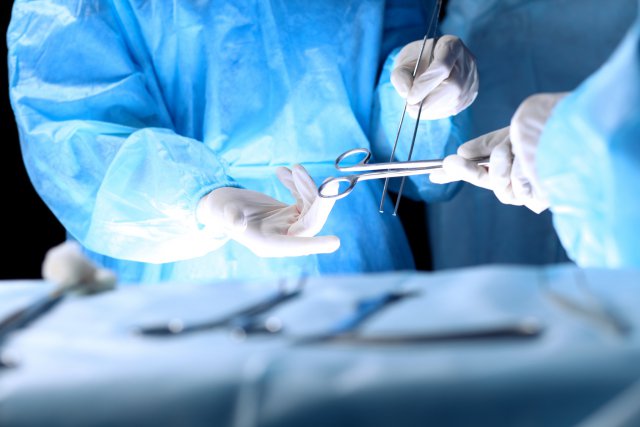
Artery removal
Resection of the section of the artery characterized by the smallest lumen is performed. Subsequently, both parts are stitched together or a prosthesis is installed in place of the removed area. This type of surgery can cause a number of complications, recovery period difficult to tolerate, but this procedure is affordable.
Folk remedies
In the treatment of atherosclerosis of the carotid arteries folk remedies used as adjuvant therapy. There are many ways to help normalize lipid metabolism and reduce cholesterol levels. At the first stage of the disease, treatment with herbs is effective. In the future, hirudotherapy is indicated. With the help of leeches, in many cases it is possible to normalize blood circulation and maintain the result for for a long time.
Before using traditional medicine, you should consult with your doctor, since with the development of atherosclerosis, a number of contraindications arise. To avoid worsening the symptoms of the disease, reduce the likelihood of vascular rupture, which provokes internal bleeding, it is necessary to coordinate treatment methods with specialists.
Diagnostics
There are several options diagnostic procedures to determine atherosclerosis of the brachiocephalic arteries:
- Ultrasound examination. Allows you to accurately diagnose the location of cholesterol plaques, their size, and also identify the speed of blood flow in a specific vessel.
- Ultrasound duplex scanning. Allows you to view the structure of the vascular walls, determine the picture of the disease, highlighting any deviations in the blood flow. When carrying out this diagnostic method, it is possible to determine the disease in the early stages of development, since the picture of the condition of the brachiocephalic arteries is viewed with maximum accuracy.
Triplex scanning is used in the development of concomitant pathologies:
- Heart failure.
- Blood diseases.
- Hypertension.
- Dystonia.
- Toxic vascular damage.
- Compression of arteries or veins.
As additional diagnostic methods CT and MRI are used. Angiography is not used, since it increases the likelihood of detachment of atherosclerotic plaques, which is especially dangerous in case of atherosclerosis of the carotid arteries.
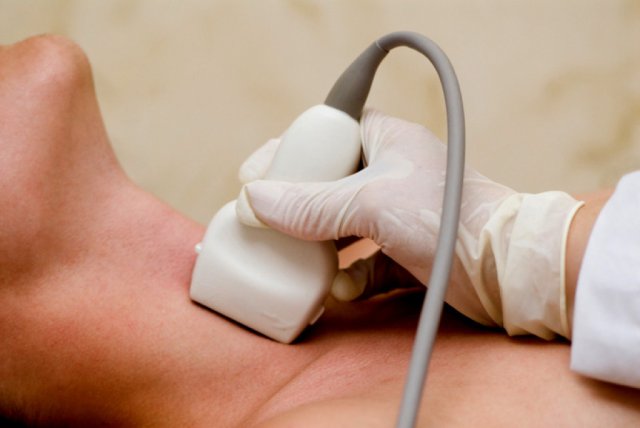
Prevention
It is important to adjust your lifestyle. This way you can restore the body and avoid many problems, including not only atherosclerosis, but also other disorders. The following ways help prevent the accumulation of excess cholesterol in the blood:
- Moderate physical activity.
- A healthy diet that includes the optimal amount of calories and healthy substances.
- Getting rid of any bad habits, in particular smoking.
With daily physical activity normal vascular tone is ensured. At the same time, smoking can provoke serious disorders of lipid metabolism, as well as the occurrence of pathologies of the cardiovascular system. For prevention to be effective, it is necessary not only to healthy image life, but also completely eliminate any bad habits.
Diet
Correct, balanced diet helps prevent the deposition of cholesterol in blood vessels, as well as eliminate other predisposing factors to the development of atherosclerosis.
Consume following products power supply:
- Fresh vegetables and fruits, juice is also useful.
- Seafood. Fish and algae help strengthen vascular walls. When consuming other products, be careful optimal level fat content
- Lean meats.
- Milk, kefir, and other products containing a minimum of fat.
- Greenery.
To prevent rendering negative influence depending on the state of the body, it is necessary to completely exclude smoked foods, fatty animal products, as well as pickled and salted vegetables and fruits from the diet. Pay attention to the frequency of food consumption and objective diet. It is advisable to eat small portions several times a day.
Consequences
Atherosclerosis of the brachiocephalic arteries, if the proper therapeutic effect is not provided, can provoke a lot of problems. Initially, patients notice a slight malaise, but as the disease develops dangerous symptoms are getting worse. If the symptoms are not relieved, there is a risk of stroke and other pathologies that have a significant impact on a person’s life.
When diagnosing and prescribing adequate treatment, it is possible to eliminate the main manifestations of atherosclerosis of the human brachiocephalic arteries and veins. It is necessary not only to carry out therapeutic measures, but also follow a diet and devote time to physical activity.
cardiogid.ru
What does the diagnosis of atherosclerosis BCA mean?
Blood circulates in the cavities of the arteries, supplying oxygen and nutrients internal organs human body. Under normal conditions, the inner walls of blood vessels remain smooth at all times, allowing unimpeded circulation. Increased level cholesterol in the blood contributes to the deposition of sediment, which over time turns into a plaque that closes the lumen of the vessel.
Stenosing atherosclerosis of the brachiocephalic arteries is diagnosed when blockage with cholesterol closes the cavity by more than 50%. This condition is extremely dangerous and requires immediate surgical intervention.
Non-stenotic atherosclerosis of the extracranial sections of the brachiocephalic arteries is determined if the plaque covers less than half of the internal lumen. IN normal conditions the pathology responds well to drug therapy.
Another common diagnosis is diffuse atherosclerosis. It develops as a result of less severe forms of the disease. The pathology is characterized by the growth of problem areas. As a rule, blockage occurs in several vessels and arteries at the same time.
What symptoms are typical?
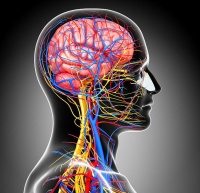 One of the most characteristic symptoms At the initial stage there is dizziness. Although this symptom may indicate other diseases, with atherosclerosis the brain constantly experiences oxygen starvation, which leads to coordination problems. The fact is that other internal organs can do without oxygen for a long time. The brain reacts sharply to any violations in this matter and sends a signal.
One of the most characteristic symptoms At the initial stage there is dizziness. Although this symptom may indicate other diseases, with atherosclerosis the brain constantly experiences oxygen starvation, which leads to coordination problems. The fact is that other internal organs can do without oxygen for a long time. The brain reacts sharply to any violations in this matter and sends a signal.
The initial manifestations of atherosclerosis of the extracranial parts of the brachiocephalic arteries without hemodynamic significant stenoses are quite difficult to determine, and often dizziness allows for timely detection pathological changes and prevent the development of the disease. Otherwise, pathological changes occur unnoticed, both for the person himself and those around him.
Causes of the disease
The etiology of the disease is not fully understood. But there are provoking factors that accelerate the formation of cholesterol plaques. Among them:
Why is BCA atherosclerosis dangerous?
WHO classifies BCA atherosclerosis as a separate group of vascular pathologies. The disease has a code according to ICD 10, which makes searching easier effective method therapy and diagnosis of changes.
 All brain vessels communicate and form a reliable connection with each other, called the Wellisian node. Atherosclerosis of even one of them leads to oxygen starvation of the entire brain and, as a result, can cause a stroke.
All brain vessels communicate and form a reliable connection with each other, called the Wellisian node. Atherosclerosis of even one of them leads to oxygen starvation of the entire brain and, as a result, can cause a stroke.
It is especially necessary for patients to be attentive if they have pain and dizziness, and attacks become more frequent and intense.
In the initial stages, atherosclerosis can be cured without surgery. Taking advantage vasodilators, drugs that control blood pressure and the appointment of physical therapy.
Combination therapy will reduce cholesterol levels without the threat of thrombosis. Additionally assigned conservative treatment aimed at overcoming unpleasant symptoms diseases and prevention of complications.
How to treat atherosclerotic lesions of the BCA
To determine the need surgical treatment, mandatory diagnostic test. The purpose of diagnosis is not only to determine the degree of closure of the lumen of the vessel with cholesterol plaque, but also the speed of blood circulation before and after the problem area. Surgery for atherosclerosis of the BCA is prescribed when ultrasound signs or angiography indicates arterial blockage greater than 50%.
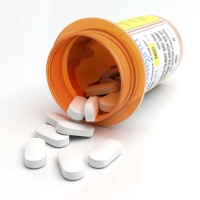 Purpose surgical treatment is the removal of a blocked section of the vessel, followed by replacement or stitching, or the installation of a stent in the artery, protecting the walls from stress and preventing tissue rupture.
Purpose surgical treatment is the removal of a blocked section of the vessel, followed by replacement or stitching, or the installation of a stent in the artery, protecting the walls from stress and preventing tissue rupture.
Drug treatment is not effective in every case. Thus, multifocal sclerosis requires surgery, since taking medications only provides a temporary reprieve from complications.
Subclinical atherosclerosis of BCA, on the contrary, responds well to therapy, since it is a direct consequence of the patient’s high blood pressure. By regulating the pressure of the cardiovascular system, the patient’s well-being is normalized.
Traditional medicine in treatment
 Folk remedies can reduce blood cholesterol levels. But in the case of an advanced stage of the disease, it is necessary to use herbal tinctures and decoctions with extreme caution, as they can provoke rupture of the vessel.
Folk remedies can reduce blood cholesterol levels. But in the case of an advanced stage of the disease, it is necessary to use herbal tinctures and decoctions with extreme caution, as they can provoke rupture of the vessel.
Hirudotherapy stabilizes blood pressure well and removes harmful substances from the body, but for patients with poor blood clotting or allergic reactions Leech treatment is contraindicated.
Diet and nutrition rules
The acceptable rate of atherosclerosis is determined by the degree of narrowing of the lumen in the arteries and vessels. If cholesterol plaque closes the channel by less than 50%, this is an indication for drug treatment, without the need for surgery.
 You can control your cholesterol levels with proper nutrition and diet, as well as the use of blood thinners (aspirin, clopidogrel).
You can control your cholesterol levels with proper nutrition and diet, as well as the use of blood thinners (aspirin, clopidogrel).
The patient is prohibited from consuming fatty meats, canned food, smoked products. You should avoid large amounts of salt and fatty fish. Indicated for consumption are “white” meat, fruits, vegetables, and seafood.
Like all other vascular pathologies, to successfully combat atherosclerosis, BCA requires accurate diagnosis, timely treatment and changing eating and living habits. The attending physician should coordinate therapy. Self-medication is unacceptable.
Atherosclerosis of the brachiocephalic arteries is a disease in the form of obstruction of the patency of the main vascular stem of the brain by formed plaques. Symptoms, stages and causes of the disease are different. Treatment is conservative or surgical.
The disease atherosclerosis of the brachiocephalic arteries is a disruption of normal blood flow in the main vessel, the brachiocephalic trunk, which extends from the main, main artery. The trunk is divided into the right subcarotid, the right common carotid and the right vertebral artery, feeding the brain and the right half of the shoulder girdle. The narrowing of blood vessels and, as a consequence, their poor patency are caused by the formation of inside walls of atherosclerotic plaques.
Damage to the brachiocephalic arteries, directly involved in cerebral circulation, poses not only a threat to the patient’s disability, but also fatal outcome. It would seem that cerebral circulation, provided by several arteries, has a lot of sources of blood supply. All of them form the so-called Wellisian circle at the base of the brain. Through it, the incoming blood is evenly distributed throughout all parts of the brain. However, an obstacle that has arisen in one of the vessels entails a significant restructuring in the work of this harmonious complex system, so that the distribution of blood is sharply disrupted. This can lead the patient to a critical condition - a stroke.
At the very beginning of development, the pathology occurs unnoticed by the patient. As it develops, the main complaint of patients with atherosclerosis of the brachiocephalic arteries is dizziness. It usually occurs during a sharp turn of the head. Sometimes - with low blood pressure. Other symptoms:
- cold extremities,
- poor concentration,
- memory impairment,
- chronic fatigue,
- irritability,
- painless ischemia,
- angina attacks,
- slight tingling or numbness in the extremities (left or right) right side), itching,
- blurred vision in one eye,
- "floaters" in the eyes,
- hearing loss (unilateral or bilateral),
- swaying,
- numbness,
- slurred speech
- nausea.
All of them can be caused by other diseases, so at the first listed signs you should consult a doctor and undergo an examination to identify atherosclerosis at an early stage. In this case, carry out effective treatment will be simpler.

The disease develops gradually, very slowly, from youth, gaining momentum by the age of 40. With age, cholesterol accumulates in the body, forming atherosclerotic plaques, which finally make themselves felt, and only from this moment can treatment begin.
The disease is divided into two stages – non-stenotic and stenotic.
- The first stage, non-stenotic atherosclerosis, when the plaque blocks the lumen of the arteries by 20-30%. During this period, there is no danger of blockage of the vessel, as well as increased blood pressure. The disease at this stage is easy to stop and quickly return blood circulation to normal.
- If at the first stage of the pathology time was lost and no treatment was provided, the second stage inevitably occurs - stenosing atherosclerosis. It is characterized by the rapid formation of plaques with significant circulatory impairment, which will have detrimental consequences for the entire body and its functioning.
Causes of the disease and diagnosis
If the causes of the disease are identified at its very beginning, both stages can be avoided. Factors that provoke atherosclerosis with subsequent brain damage are the following:
- Overweight. This is the first, most common factor in the development of pathology. The brain in people with large body weight most often suffers due to damage to the vessels that supply it.
- Alcohol abuse and smoking(when it enters the body, tobacco disrupts the barrier function of the endothelium, which is why inflammatory blood cells - lymphocytes - penetrate).
- Chronically high blood pressure. It can both cause atherosclerosis of the brachiocephalic arteries and provoke a stroke. Blood pressure is monitored using a tonometer. High blood pressure, when its upper scale shows 140, and the lower one – 90-100. Normal blood pressure is on average 120 over 80.
- Lipid metabolism disorder. As a result, the cholesterol content is higher than normal, and plaques form from its deposits. They are attached to the walls of the vessel, gradually increasing in size, and then break away from them and travel through the body with the blood flow. Their danger is their ability to clog small vessels. To avoid various serious complications, cholesterol levels must be controlled.
- Taking contraceptive medications.
- Sedentary lifestyle.
- Impaired glucose tolerance or latent diabetes.
Diagnosis of atherosclerosis of the brachiocephalic arteries is carried out using ultrasound of the cervical arteries in combination with a Doppler study, which reveals not only the location of the lesion and the degree of narrowing of the lumen, but also the direction of blood flow and its speed in various parts of the complex blood system. The obtained research data, taking into account the patient’s complaints, will determine the treatment tactics - whether it will be medicinal or surgical.
Treatment and prevention
Atherosclerosis of the extracranial parts of the brachiocephalic arteries is treated conservative methods in case the disease did not have time to go too far. Pursued goals of drug therapy:
- Control and maintenance of normal blood pressure.
- Maintaining an active lifestyle.
- Monitoring cholesterol levels.
- Avoiding stress.
As a rule, the patient is prescribed to take anticoagulants and antiplatelet agents. In general, the following groups of drugs are used against atherosclerosis:
- preventing the absorption of cholesterol and reducing its production in the liver ( a nicotinic acid, fibrates, plant sorbents, statins);
- excreting atherogenic lipoproteins (preparations based on unsaturated fatty acids);
- nourishing the endothelium, as well as synthetic prostacyclin substitutes and vitamins A, E and C.
Treatment requires a complete cessation of bad habits, which cannot be resumed even after treatment. Along with medications, at the early stage of the disease, you can use centuries-old folk remedies that have proven their effectiveness in the fight against atherosclerosis.
One of the most widely used is garlic. Eating half a clove a day can help significantly, as garlic stimulates metabolic processes in the body, having a particularly beneficial effect on lipid metabolism. Numerous infusions based on rose hips and various herbs are also used.
When starting to take it, you should consult your doctor.
TO surgical method are used exclusively in cases of severe damage to blood vessels. There are several types of surgery:
- Open surgery. It consists of removing the affected area, after which the vessel is prosthetic or sutured.
- Endovascular surgery. In this case, a stent is installed at the location of the plaque (an elastic frame placed in the lumen of the vessel and ensuring its expansion). This type of intervention is not complicated and gentle. The patient recovers in just a few days. However, such an operation is quite expensive, so not every patient can afford it.
- Eversion carotid endarterectomy. This is an open operation, during which the plaque is removed from the vessel and then its integrity is restored.
 For vascular health, in order to prevent atherosclerosis, you need to change your lifestyle to a healthy and active one. Proper nutrition is of great importance. It should consist of lean meats and dairy products, seafood and be rich in vitamins in the form of vegetables and fruits. You need to exercise moderately, try to avoid stress and forget about bad habits. After all, any treatment is a long, difficult process, and timely prevention is easy way avoid it!
For vascular health, in order to prevent atherosclerosis, you need to change your lifestyle to a healthy and active one. Proper nutrition is of great importance. It should consist of lean meats and dairy products, seafood and be rich in vitamins in the form of vegetables and fruits. You need to exercise moderately, try to avoid stress and forget about bad habits. After all, any treatment is a long, difficult process, and timely prevention is easy way avoid it!
Additional Information

Not every person has an idea of why BCA atherosclerosis develops, what it is and how to treat patients. This pathology is characterized by the formation of plaques in the vessels of the brain. Most often, the brachiocephalic trunk is affected, which branches into the carotid, vertebral and subclavian arteries. These are large vessels that supply the brain.
Development of cerebral atherosclerosis
Stenosing atherosclerosis BCA is a disease characterized by the deposition of atherogenic lipoproteins on the inner wall of blood vessels, which leads to narrowing of the artery and disruption of blood flow. Chronic or acute cerebral ischemia develops. This is one of the most common neurological diseases. Older people are more likely to face this problem.
Deposition of lipoproteins is possible at a young age. The first symptoms appear after 50 years. The danger of atherosclerosis of the brachiocephalic arteries is that it can cause chronic ischemia. This increases the risk of developing acute cerebrovascular accident (stroke). The share of this pathology in the general structure of vascular diseases reaches 50%.
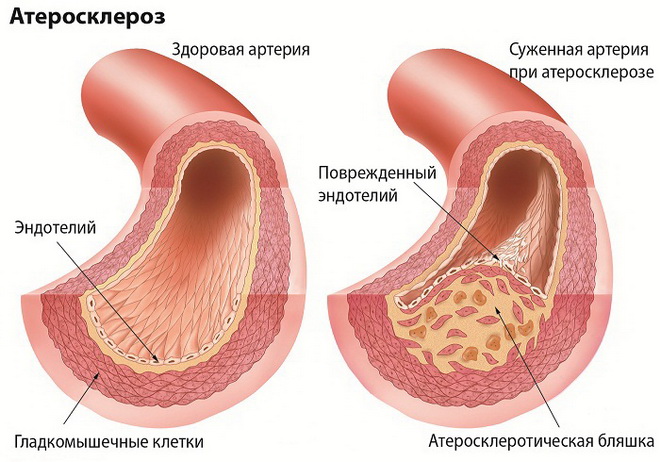
Mechanism of development of atherosclerosis
You need to know not only what atherosclerosis is, but also its pathogenesis. The development of this pathology is based on dyslipidemia. This is a disorder of fat metabolism, which results in the formation of plaques. There is cholesterol in human blood. It is associated with lipoproteins. The latter are atherogenic and antiatherogenic.
The first group includes low and very low density lipoproteins. They are the ones who clog the blood vessels. High-density lipoproteins do not play a role in the development of the disease. In atherosclerosis, mainly the main arteries and their branches are affected. There are 3 known stages of development of this pathology:
- lipid stain;
- liposclerosis;
- calcification.
Stenosing atherosclerosis of the brachiocephalic arteries develops over several years. At the first stage, lipid spots are formed. This occurs as a result of the impregnation of the vascular endothelium with fats. At this stage there are no symptoms. The second stage is characterized by the migration of immune cells (leukocytes). Connective tissue grows.
Fibrous plaques form. The lumen of the vessel narrows. Stage 3 is different in that calcification develops at the site of damage. The plaque thickens. The reason is the deposition of calcium salts. Over time, the plaques increase in size, partially or completely blocking the lumen of the branches of the brochiocephalic trunk (BCS). The most dangerous is acute blockage of the arteries.
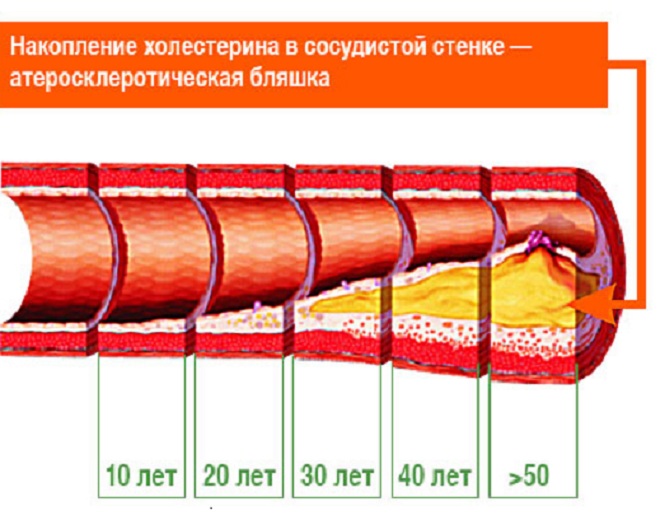
Main etiological factors
Atherosclerotic lesions of the brachiocephalic arteries with stenosis are due to several reasons. The following etiological factors are of greatest importance:
- arterial hypertension;
- smoking;
- excessive intake of animal fats into the body;
- lack of vitamins;
- obesity;
- genetic predisposition.
The condition of the vascular wall directly depends on the nature of nutrition. Excessive consumption of fatty meat, butter, mayonnaise, fried foods, sausages, cream, chips is a risk factor for the development of cerebral atherosclerosis. Large amounts of simple carbohydrates have an adverse effect on the body.
This contributes to obesity. People who consume a lot of plant foods suffer from atherosclerosis much less often. A risk factor for the development of this vascular pathology is a lack of vitamins and minerals. Manifestations of atherosclerosis are often combined with signs of arterial hypertension. Damage to the brachiocephalic vessels does not occur without the participation of predisposing factors. These include:
- alcohol addiction;
- physical inactivity;
- presence of atherosclerosis in relatives;
- hormonal disbalance;
- elderly age;
- stress;
- diabetes.
Today, millions of people around the world smoke. Inhaled harmful substances damage the walls of blood vessels, leading to atherosclerosis. Smokers have a tenfold higher risk of developing this disease. People with diabetes often suffer from atherosclerosis. The reasons are increased blood pressure and metabolic disorders.
Clinical manifestations of the disease
Symptoms of atherosclerosis of the brachiocephalic vessels are nonspecific. In the early stages, a person’s condition may not be affected. The most commonly identified symptoms are:
- daytime sleepiness;
- weakness;
- decreased performance;
- lethargy;
- irritability;
- disturbance of night sleep;
- decreased concentration;
- dizziness;
- memory loss;
- noise in the ears or head;
- depression;
- headache.
Over time, the behavior of a sick person changes. He becomes irritable, apathetic, suspicious. Such people cannot remember current events. The noise in my head becomes constant. Speech changes. She becomes fuzzy. Progressive atherosclerosis often manifests itself as vestibular ataxia. This is a condition in which coordination of movements is impaired.

Movement disorders such as limb tremors are possible. Some patients experience seizures. In severe cases, epilepsy attacks occur. Frequent symptoms of stenosing atherosclerosis are decreased vision and hearing. The reason is oxygen deficiency in the brain. Hearing loss often develops. In the absence of proper treatment, a sick person gradually loses his ability to work. Prolonged ischemia leads to dementia (dementia) and memory loss.
A person forgets what he did just recently. Severe speech dysfunction develops. Orientation in space is difficult. Previously existing interests in atherosclerosis disappear. Patients stop paying attention to their appearance. The initial stages of the disease respond well to treatment. In advanced cases, patients need outside help.
Possible consequences of atherosclerosis
Stenosing atherosclerosis of the carotid arteries can lead to complications. This happens if the patient does not go to the clinic and does not change his lifestyle. The following consequences are possible:
- development of ischemic stroke;
- speech disorders;
- decreased visual acuity;
- loss of ability to work;
- dementia;
- paralysis;
- microstroke.
The most dangerous is acute cerebrovascular accident. A heart attack (ischemic stroke) often develops. It presents with ataxia, dizziness, double vision, dysarthria, weakness and dysphagia. Mortality with this pathology in the first month reaches 20-25%. The hemorrhagic form of stroke develops less frequently. This is possible if cerebral atherosclerosis is combined with thrombosis, hypertension or aneurysm.
Methods of examining patients
There are many different ways to detect cerebral atherosclerosis. The following studies are being carried out:
- lipid profile;
- biochemical blood test;
- ultrasound Dopplerography of blood vessels;
- duplex scanning;
- Magnetic resonance imaging;
- study of blood flow in the veins and arteries of the head and neck;
- general blood and urine tests;
- pressure measurement;
- audiometry;
- study of eye structures.
Electroencephalography is required to assess brain function. The most modern and informative diagnostic method is tomography. It can be computer and magnetic resonance. Such a study allows us to identify atherosclerosis of the extracranial parts of the brachiocephalic arteries.
The initial examination of the patient is also important. During it, the condition of vital organs is assessed and blood pressure is measured. Risk factors for the development of atherosclerosis must be identified. A thorough collection of a life history helps with this. Echographic signs of stenotic atherosclerosis are of great importance. Differential diagnosis includes encephalitis, meningitis, cranial trauma, neurosyphilis, intracranial hypertension and stroke.
An integrated approach to treatment
When atherosclerosis of the brachiocephalic arteries is detected, treatment should be comprehensive. The following tasks are pursued:
- stopping the growth of plaques;
- prevention of complications;
- restoration of impaired functions;
- elimination of symptoms;
- maintaining ability to work.

First of all, you need to change your lifestyle. To do this you will need:
- quit smoking;
- move more;
- give up fatty and fried foods;
- take vitamins;
- give up alcohol.
It is impossible to completely get rid of atherosclerotic plaques. Every experienced neurologist knows the symptoms and treatment of this disease. For cerebral atherosclerosis, the following medications are prescribed:
- statins;
- antihypertensive drugs;
- vasodilators;
- drugs that improve microcirculation and metabolism.
The most important component of therapy is the correction of blood lipid composition. The drugs of choice are statins. These are medications that reduce the concentration of atherogenic lipoproteins. The most commonly prescribed drugs are Atorvastatin-Teva, Liprimar, Torvacard, Atoris, Holetar, Rovacor, Atherostat, Zocor, Simvor.
If they are intolerant, fibrates are used. The treatment regimen includes medications that improve metabolism and mnestic functions. These include nootropics (Piracetam, Cerebrolysin), as well as Actovegin, Vinpocetine and Pentoxifylline. To reduce the risk of stroke, antiplatelet agents are prescribed (Trombo Ass, Aspirin Cardio, Tiklid, Tiklo).
For hypertension, lifelong use of blood pressure-lowering medications (calcium channel blockers, beta-blockers or ACE inhibitors) is indicated. Additionally, antioxidants are prescribed. To eliminate ischemic disorders, iodine preparations and Polysponin can be used.
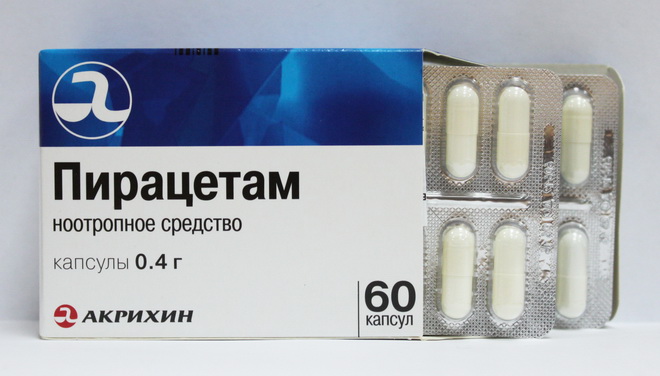
In severe cases, they resort to radical measures. The following types of interventions are carried out:
- endarterectomy;
- formation of anastomoses;
- prosthetics;
- stenting;
- balloon plastic.
Radical treatment is indicated for acute vascular occlusion, microstrokes and narrowing of the arterial lumen by 70% or more.
Therapeutic nutrition for atherosclerosis
You can stop the progression of the disease with proper nutrition. The following recommendations must be followed:
- exclude from the diet foods rich in animal fats and simple carbohydrates;
- eat more fresh fruits, vegetables, herbs and berries;
- reduce the amount of salt consumed;
- include fish and seafood in the diet;
- introduce fasting days.
There is no need to reduce the amount of animal protein. Patients need to limit the consumption of egg yolks, fatty meats (pork, beef, lamb, duck) and fish, mayonnaise, butter, caviar, offal, and sausages. Salads need to be dressed with olive oil. It is recommended to eat foods that are rich in lipotropic compounds. Thus, cerebral atherosclerosis is very dangerous disease. The prognosis depends on the completeness and timeliness of treatment. Ignoring symptoms of illness is main reason development of serious complications.
Human organism - This is a well-functioning system. All organs and blood vessels work like a clockwork. But sometimes an extra little thing throws everything out of order. For example, a seemingly harmless piece of fat. And from it an atherosclerotic plaque is formed, which causes significant problems. One of serious pathologies cerebral vessels is non-stenotic atherosclerosis of the extracranial brachiocephalic arteries. This is a violation of patency in a certain area blood vessel. The condition occurs due to the proliferation of atherosclerotic plaque. Blood circulation pathologies in this area are very dangerous. The veins and arteries of the head form the Circle of Willis. This anatomical and physiological formation is responsible for uniform blood supply to all parts of the brain and sensory organs. The vessels of the circle also nourish the shoulder girdle. Therefore, fat overgrowing the lumen of the vein in the head can cause pain and numbness in the arm. After all, everything in the body is connected.
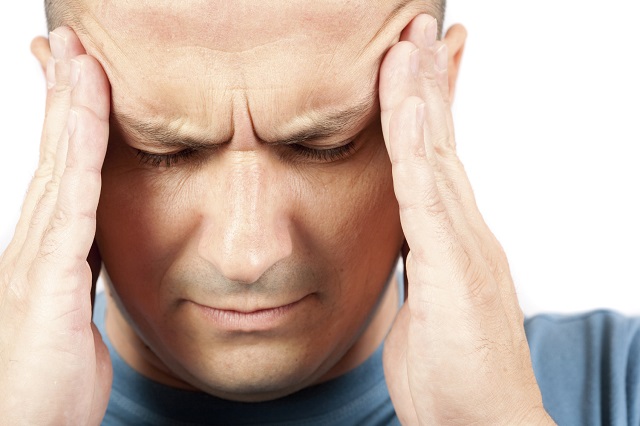 Frequent severe pain- are the main sign of vascular blockage
Frequent severe pain- are the main sign of vascular blockage Causes of atherosclerosis of the brachiocephalic arteries
Non-stenotic atherosclerosis is very insidious and is diagnosed by doctors only when the lumen of an artery or vein is blocked by more than 50%.
There are many theories about the origin of atherosclerosis. Some cardiologists argue that body fat begin to form after undergoing infectious diseases. Other phlebologists believe that circulatory pathology occurs due to a congenital predisposition.
Provoking factors for narrowing the lumen of the arteries and veins of the head are:
- smoking. Everyone has once heard that a drop of nicotine kills a horse. But did you know that the substance affects the thickness of blood plasma, increasing its viscosity several times. If at a young age the body copes with increased stress on cardiovascular system, then over time the compensatory abilities dry up. Therefore, smokers with experience are at risk;
- passion for strong alcoholic drinks. Alcohol causes fragility of blood vessels. As soon as ethyl alcohol enters the body, it causes their sharp expansion. But after 1–2 hours a spasm begins. Not every organism, especially in adulthood, can withstand such fluctuations;
- hypertension. Patients with chronically elevated blood pressure have every chance of receiving a diagnosis of atherosclerosis of the brachiocephalic vessels. Constant pressure internal walls veins negatively affects their lumen and quality of blood circulation;
- excess body weight. With an excess of subcutaneous and visceral fat, the likelihood of overgrowing the lumen of blood vessels and the formation of atherosclerotic plaques increases;
- physical inactivity. Few people today have a non-office job and are active during the working day. If you sit for more than 8 hours, then there is a high probability of developing atherosclerosis of the vessels of the head.
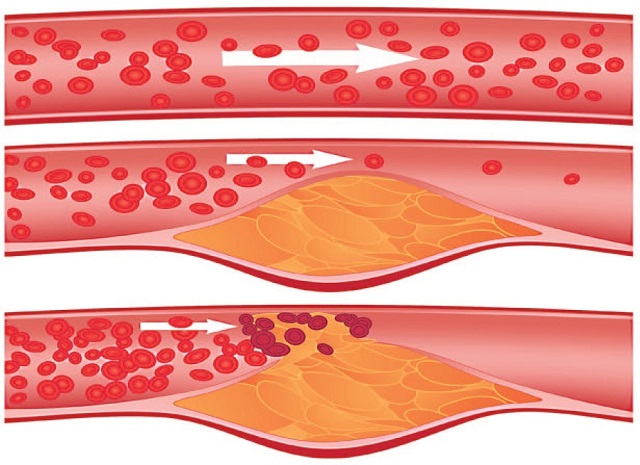 Plaque formation
Plaque formation Symptoms
Alarming signs of extracranial overgrowth with cholesterol plaques:
- headache. Violation of the patency of the veins or arteries of the brain is always accompanied by discomfort. Many patients attribute the pain to migraines or fatigue. In such situations, people try to drink more coffee or energy drinks. But this cannot be done. Chemical substances additionally narrow the lumen of veins and arteries. Their systematic use provokes a stroke and the headache gets worse each time;
- decreased memory and attentiveness. Poor circulation always affects brain activity. Oxygen starvation and glucose deficiency negatively affect performance. It is difficult for a person to concentrate on routine work, he often makes mistakes or cannot remember simple things. There is no need to attribute such symptoms to overwork. These are signals of “starvation” of brain tissue, and, therefore, hypothetical circulatory pathologies;
- hearing and vision impairments. The patient experiences bright flashes before the eyes or “spots”. When the lumen of blood vessels becomes overgrown with atherosclerotic plaques, there are auditory hallucinations or sudden loss hearing in one ear;
- dizziness with sudden movements, bending and turning the head. Many people attribute the symptom to lack of sleep or weather sensitivity, and at this time brain tissue suffers;
- slurred speech. With chronic problems with the patency of arteries and veins, the patient may have problems with pronunciation. Relatives suddenly notice that it has become difficult to even understand simple words. All this is due to a lack of nutrients and oxygen in a certain area of the brain;
- nausea. If the symptom occurs without injury or poor quality food, then the patient should be wary;
- tingling in the limbs or, conversely, loss of sensitivity.
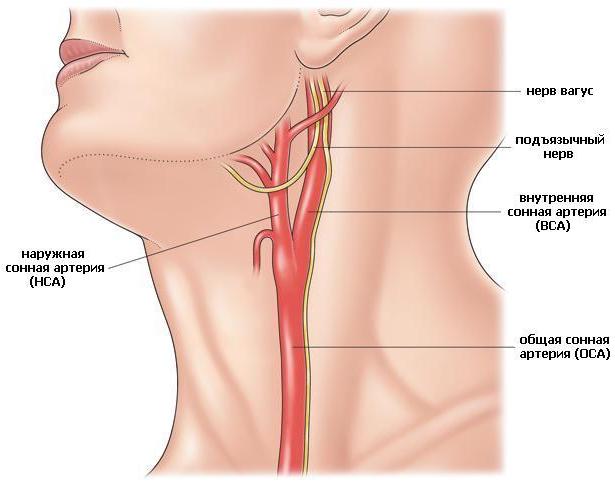 Example of brachiocephalic arteries in the human neck
Example of brachiocephalic arteries in the human neck Modern diagnostic methods
To identify circulatory pathologies of any part of the brain or head, several methods are used:
- Dopplerography. A universal, painless and operative technique is ideal for patients of any age to identify atherosclerotic plaques or lipid stains (harbingers of atherosclerosis). Under the influence of ultraviolet rays, the device shows in real time the speed of blood flow, the fullness of blood vessels and the state of the lumen;
- MRI and CT will help identify impaired patency of the veins and arteries of the brain. Ultrasound has difficulty passing through the dense bone plates of the skull. Therefore, if cholesterol deposition is suspected, MRI and CT are indispensable. A clear picture with high resolution in several projections is displayed on the screen. This makes it easier for surgeons to plan surgery to remove atherosclerotic plaque;
- blood biochemistry. The analysis fully reveals the picture of metabolism. With atherosclerotic plaques, the level of lipids and specific substances increases several times. For availability inflammatory process in the lumen of the vessels the changed leukocyte formula will indicate;
- lumbar puncture. This is a miniature surgical procedure. Under sterile conditions, a small amount of cerebrospinal fluid (the fluid that surrounds the spinal cord and brain) is removed. The analysis shows the presence of stroke and additional pathologies in the brain tissue;
- encephalogram. Used in advanced cases. Diagnostics shows the activity of the brain, the alternation of different impulses and the activity of different areas.
In advanced conditions with stenosis, consultations with a neurologist, endocrinologist and other specialists may be necessary. For example, a blood test to determine hormonal levels guarantees high-quality treatment of patients with circulatory pathologies.
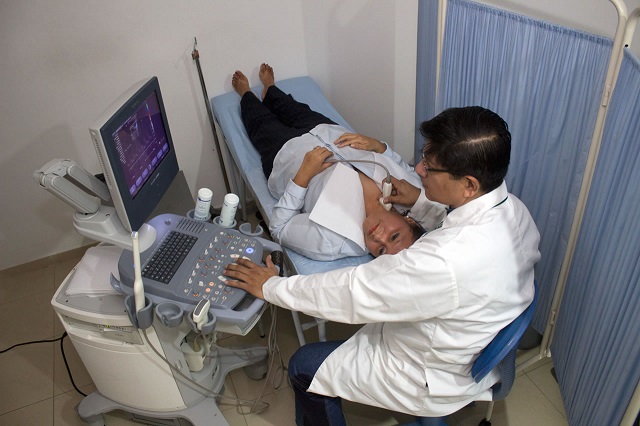 Ultrasound Dopplerography of arteries will help prevent atherosclerosis
Ultrasound Dopplerography of arteries will help prevent atherosclerosis Correction methods
Modern medicine treats the disease with:
- surgical intervention. Depending on the stage of atherosclerosis, the extent of the affected area, and the patient’s age, endarterectomy and arteriotomy are used. During the operation, cholesterol deposits are removed from the lumen. In case of serious damage to a vein or artery, the area is replaced with hypoallergenic materials;
- medications. For cholesterol deposits, anticoagulants are used in treatment. The substances prevent the formation of blood clots near atherosclerotic plaques. But doctors constantly monitor blood clotting. They are also used to strengthen the walls of veins and arteries. Special preparations improve blood circulation in the brain, restore memory and mental abilities. Such medicines often contain herbal extracts of red clover or ginkgo biloba, or walnut, Omega-6 and shark liver extracts. All medications are selected only by a doctor, and self-medication is inappropriate;
- diet therapy. Surgery radically solves the problem. But it depends on the patient whether atherosclerotic plaques will reappear in the lumens of his vessels. Therefore, in case of pathology, special nutrition is prescribed. The amount of salt in the diet is brought to a physiological minimum. Patients exclude marinades, pickles, smoked meats, sausages and frankfurters, and increase the amount of water. Patients need to drink at least 2.5 liters of fluid daily, then the blood plasma will have normal density, and the risk of stroke will be reduced several times. The basis of the diet is plant and dairy foods.
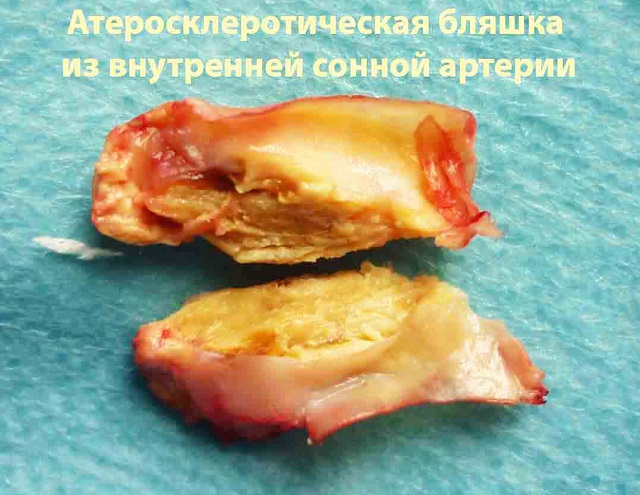 Atherosclerotic vessel from the inside
Atherosclerotic vessel from the inside Consequences of advanced atherosclerosis CBA
Atherosclerosis of the extracranial sections of the brachiocephalic arteries with stenting brings a lot of trouble to patients. Few people immediately pay attention to health problems, and at the first alarming symptoms seeks help from neurologists and phlebologists. But neglected conditions often lead to consequences such as:
- brain failure. Poor circulation in the head directly leads to problems with memory and attentiveness. Simple things are difficult to do, and working on a computer turns into hard labor. To stimulate activity and performance, patients take caffeine or energy drinks. But neuropathologists and phlebologists prohibit doing this. Drinks with stimulants cause spasms of veins and arteries, increase blood density and increase the chances of stroke and other complications;
- stroke. When the lumen becomes overgrown with fatty plaques, the blood pressure in this area increases several times. Weakened and inflamed walls are unable to resist the disease. Therefore, their breakthrough and massive hemorrhage occur. All this is a direct threat not only to human health, but also to human life. If in the first hours after a stroke you do not provide adequate medical care, do not enter medications, then oxygen starvation of brain tissue occurs. Speech and vision disorders, partial or complete paralysis, disability – these are not horror stories, but real consequences stroke. Therefore, if you notice symptoms of circulatory disorders or are diagnosed with atherosclerosis of the vessels of the head, do not be negligent about your health and begin treatment immediately.
Ideally, every person should constantly engage in prevention cardiovascular diseases. We will tell you about preventive measures in more detail.
Prevention
Prevention of vascular pathology – the main task of doctors. Prevention is relevant not only for older people, but for everyone age categories. The insidiousness of stenosing disease is that it is difficult to identify in the initial stages. Therefore, take care of the condition of the lumen of blood vessels in advance.
Stenosing atherosclerosis BC can be effectively prevented with the help of:
- balanced nutrition. Cardiac pathologies recede before unsaturated ones fatty acids. The substances are found in seafood, fish and caviar, nuts and olive oil. If not everyone allows themselves to be pampered with sea delicacies, then it is quite possible to include other products in the daily menu. Also avoid smoked meats, pickles and marinades. Excessive salt concentration increases blood density, increases the likelihood of blood clots and complicates the patency of blood vessels;
- exercise daily. Physical activity within 30 minutes – best prevention atherosclerosis. No one expects you to live in a gym or be a professional athlete. Do what you can do and what brings you joy. Walking tour, cycling, light jogging, going to the pool – All this will charge you with positivity and keep your muscles and arteries of the head in good shape. The main thing is regularity;
Competent alternation of physical, mental activity and rest. Nowadays everyone is a workaholic. It is already considered the norm to combine 2 jobs or after a hard day to continue running errands. The Internet also steals precious minutes of rest and hours of sleep. Remember that an adult should sleep at least 8 hours every day. If the indicator falls, the level of hormones is disrupted, increasing the risk of stroke and other circulatory pathologies. Therefore, get good sleep and enjoy life. Then atherosclerosis of the brachiocephalic vessels will not have a chance to harm you.
